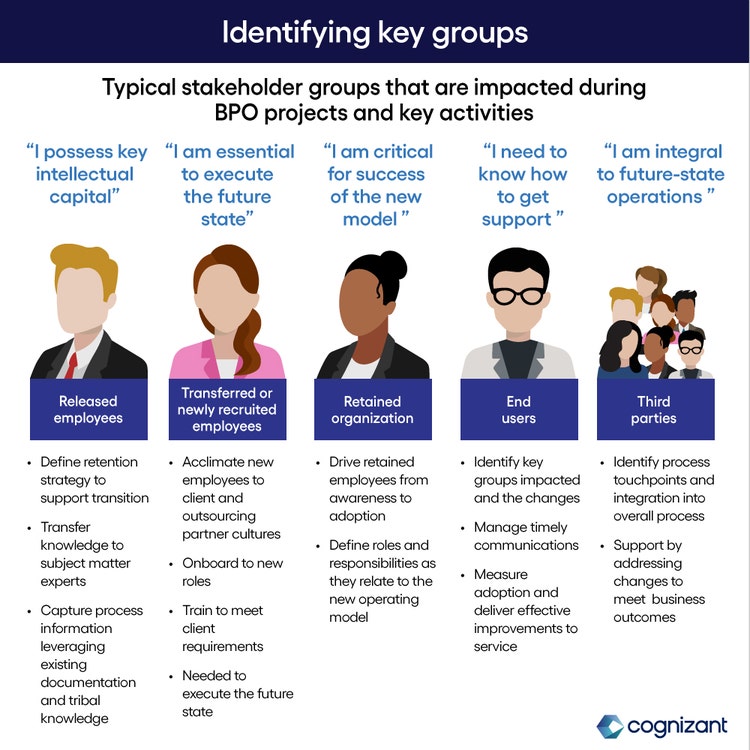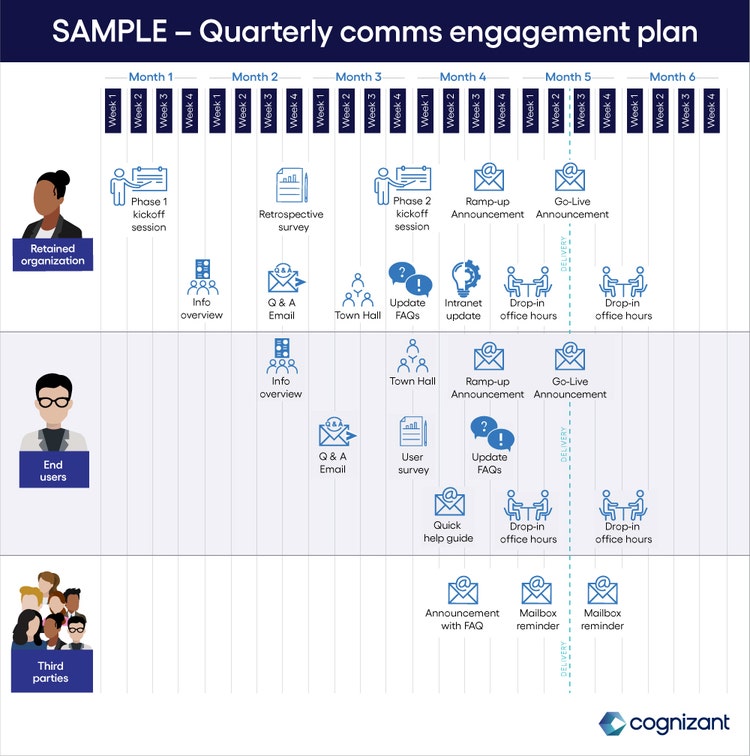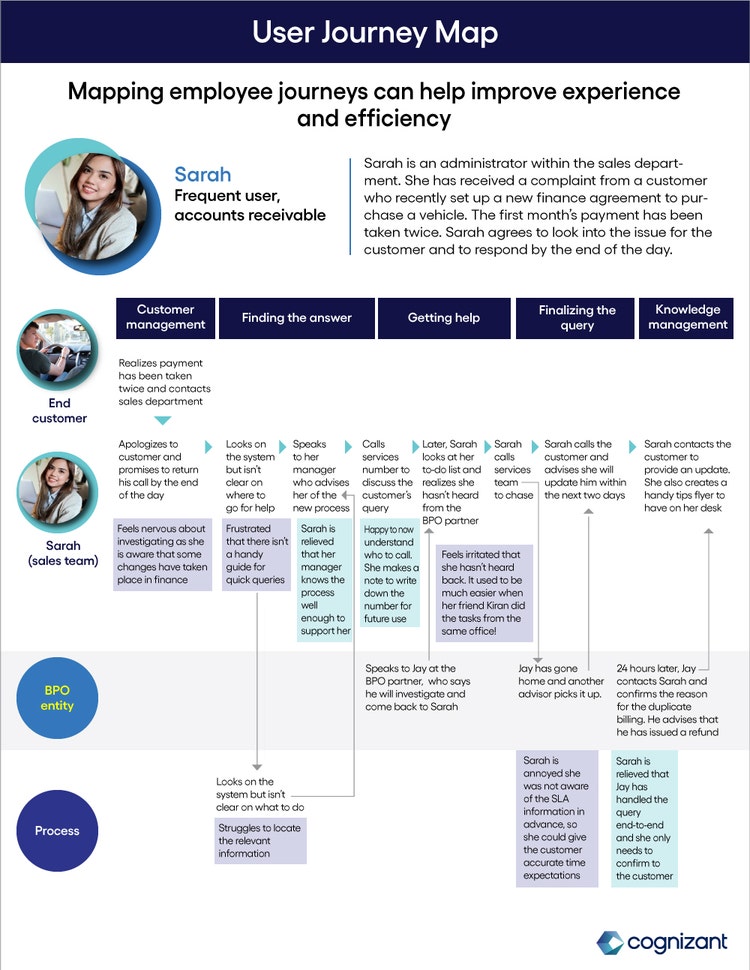
The hidden challenges of lift-and-shift BPO styles-text-white
data-xy-axis-lg:null; data-xy-axis-md:90% 0%; data-xy-axis-sm:90% 0%
<p><br> February 27, 2023</p>
The hidden challenges of lift-and-shift BPO
<p><b>Lift-and-shift BPO requires more change management than many think. Here are four strategies to ensure the transition is a successful one.</b></p>
<p>Once upon a time, an organization decided to move its billing and accounts receivable processes to an outsourcing partner in a faraway land, opting for a lift-and-shift <a href="/content/cognizant-dot-com/us/en/glossary/business-process-outsourcing.html">business process outsourcing (BPO)</a> approach. The move helped the company cut costs and gave key employees more satisfying, strategic roles.</p> <p>Since the process work was essentially unchanged—just done by other hands—the transition was kept discreetly behind the scenes. Everything went off without a hitch. Other than those who used to do the process work, no one even noticed.</p> <p>And then there’s reality. After the processes were outsourced, a sales administrator got a customer complaint about a double billing. Previously, she would have contacted her friend in accounts; however, her friend had left the company.</p> <p>Aware some sort of change had occurred in finance, the admin struggled to track down a contact name and number. When she finally got the information, she logged the complaint. After not hearing back after 24 hours, she called again and learned the service level agreement (SLA) was a 48-hour response (she had never heard of “SLAs” before).</p> <p>The next day, she was notified the issue was resolved, and a refund had been issued. She was pleased with the resolution speed but decided to create an informational flyer for her colleagues so they would have the right information to give customers and wouldn’t have to experience the same frustration she had.</p> <h4>The reality of lift-and-shift BPO</h4> <p>As many of us in the BPO industry know, a successful BPO transition takes thoughtful planning and expertise, whether it’s finance, HR, IT or other processes. But too many businesses believe the myth that a lift-and-shift approach to BPO has a limited impact on employees’ ability to get work done productively. After all, they might think, you’re merely moving an existing process to another provider, not re-architecting how the process is done, which would be more obviously disruptive.</p> <p>The fact is, lift and shift affects service users and external parties in both hidden and overt ways. And the failure to consider and plan for these impacts can be costly, as it can mire companies in the immediate transition instead of moving into a higher-level phase of transformation.</p> <p>To maximize BPO success, businesses need to pay as much attention to the people aspect of the change as the technical and operational aspects, and make rigorous, structured change management an integral part of the program. Doing so will identify impacts, mitigate risks and deliver a smooth user experience, enabling the business benefits to be realized more rapidly.</p> <h4>Putting lift and shift in context</h4> <p>To draw an analogy, imagine you moved to a new area, but instead of dealing with all the disruptions of packing and moving all your belongings, you’re able to just take your house with you—lift it up and put it on a new foundation. However, once you move in, you start to realize things don’t work quite like they should. Your favorite chair to watch the sunset must be moved because the window it’s next to no longer faces west. You can’t bring your dog in from the back garden because the back door is now against the neighbor’s wall. And you still need to memorize a new address and get registered at the local doctor.</p> <p>Similarly, the process of lifting and shifting a business process is filled with unexpected effects and adjustments: Processes undergo change, work gets divided at different points, the technology is new, the people and culture are different.</p> <p>Acknowledging and planning for disruption upfront allows the organization to minimize its effects and be better positioned for the seamless transition they hope for. Importantly, a smooth BPO transition goes beyond face value: It can pave the way to digitally transformative tools and platforms, which ultimately bring higher value to the outsourcing partners.</p> <h4>Four strategies for a successful transition</h4> <p>Based on our experience with numerous BPO clients, we have identified four key strategies to support a seamless lift-and-shift BPO transition.</p> <h5 style="margin-left: 40.0px;"><span style="font-weight: normal;">Strategy 1: Accurately assess the changes to organizational structure, roles and competencies</span></h5> <p style="margin-left: 40.0px;">When processes themselves are supposedly not changing all that much, it’s easy to underestimate how significant the <i>people</i> changes are—especially in terms of org structures, role expectations and capability requirements.</p> <p style="margin-left: 40.0px;">Depending on the stakeholder, concerns may include job security, new roles and responsibilities, losing colleagues, adapting to new processes and technologies, learning different ways of working, interacting with unfamiliar cultures, and new performance measures.<br> <br> That’s why one of the first steps in a rigorous change management effort is to define <i>stakeholder groups—</i>for example, released employees, new transfers and end users. Figure 1 illustrates a sample of stakeholder groups in a typical BPO transition. By defining stakeholder groups, businesses can imagine the transition from various users’ points of view—and, in turn, correctly forecast the degree of actual change.</p>

#
<p><span class="small">Figure 1</span></p> <p style="margin-left: 40.0px;">For example, we worked with a company outsourcing its finance processes, with the intention of freeing up its retained team to become more strategic. However, because the new roles, competencies and expectations weren’t designed in advance, the individuals were reluctant to let go of their old roles, leading to confusion and frustration on both sides and, importantly, a poor customer experience.<br> <br> By providing a clear vision and direction of travel for each of the key stakeholder groups, however, the business could ensure people have something meaningful and positive to move toward.</p> <h5 style="margin-left: 40.0px;"><span style="font-weight: normal;">Strategy 2: Communicate, communicate, communicate</span></h5> <p style="margin-left: 40.0px;">Communication is the bedrock of effective change management. But too often, company leaders are hesitant to share news about an outsourcing transition, believing “they don’t need to know,” “it won’t impact them” or “it’s an internal initiative to improve service.”<br> <br> This is a mistake. Reluctance to communicate leads to longer term problems: quiet resistance, a poor employee or customer experience, reputational damage and more.<br> <br> At the same time, timing is critical and must be carefully managed. We received a desperate call from one organization that had told their 60-strong leadership team “in strictest confidence” about the outsourcing but hadn’t kept their corporate communications team involved. Suddenly, the organization had to manage fall-out when the news inevitably leaked into the public domain.<br> <br> The first group that needs to be communicated with are the employees who will be most impacted through a job loss or a major role change. From the outset, identify the key people who need to be retained, whether longer term or for the period of the transition, communicate their vital role in knowledge transfer, and be clear about how their cooperation will be acknowledged and rewarded.<br> </p> <p style="margin-left: 40.0px;">HR departments, rather than change management providers, are best suited to manage this type of communications. Where change management teams play a crucial role is with the impacted service users, wider business and external contacts.</p> <p style="margin-left: 40.0px;">A well-conceived and executed communication plan, coordinated with HR and corporate comms, will provide the right messages to the right people at the right time. It sets the scene, manages expectations, creates confidence and encourages buy-in.</p> <p style="margin-left: 40.0px;">Communication should start early in the endeavor and continue throughout the transition. Early messaging should be precisely crafted to convey the <i>why</i> and <i>why now</i> of the transition, along with crisp explanations of <i>what’s changing</i> and <i>what’s not. </i>Perhaps most important for buy-in are the messages about benefits, namely <i>what’s in it for me</i> and <i>what’s in it for the organization</i>. Even when transition details are still being worked out, delivering these key messages instills a sense of confidence.</p> <p style="margin-left: 40.0px;">As the project progresses, the communications should get more detailed, drawing upon user experience (UX) maps (described in the next section) and stakeholder group exercises to explain new ways of working and even the vocabulary commonly used in BPOs, which may be unfamiliar. Throughout, provide multiple avenues for users to ask questions, give feedback and engage in open discussions. Figure 2 offers a birds-eye view of communication touchpoints across defined groups.</p>

#
<p><span style="font-weight: normal;"><span class="small">Figure 2</span></span></p> <h5 style="margin-left: 40.0px;"><span style="font-weight: normal;">Strategy 3: Vigorously test end-to-end processes</span></h5> <p style="margin-left: 40.0px;">Our third strategy is to conduct a thorough test-drive period. It’s not enough to focus solely on the in-scope changes. A change that may initially appear to affect only one department or user group often causes ripple effects in unexpected places.</p> <p style="margin-left: 40.0px;">A key element of testing is to create a UX map and continually adjust it as the testing process plays out. For example, we worked with a client that sells automotive vehicles to move its finance operations to our organization, with the understanding that processes should initially remain as-is. While preparing for this move, our change management practitioners dug into the actuality of what this client’s end customers would experience.</p> <p style="margin-left: 40.0px;">Specifically, we drew up UX process maps for a range of scenarios, an example of which is shown below in Figure 3. By mapping out highly detailed, end-to-end user experiences, we helped the client uncover potential difficulties they hadn’t considered. After identifying and averting these pain points, the client ensured a more successful transition.</p>

#
<p><span class="small">Figure 3</span></p> <p style="margin-left: 40.0px;">In another example, we worked with an organization to outsource its frontline technical support. After a rigorous testing phase, we discovered an issue in the handoff of more complex queries to the internal team. The internal team continued to manage its ticketing timelines as it always had, but there was a mismatch with the agreed-upon service levels for the outsourced support. Since this disparity came to light before go-live, the client was able to amend process details and harmonize the two approaches prior to launch.</p> <p style="margin-left: 40.0px;">In our experience, pilots or trials with smaller processes or teams can work best, as it is almost invariably more efficient to start small, work out the kinks and then scale. For technical issues, a best practice is to create a model office that brings together team members, mimics the user journey through numerous scenarios and documents glitches, such as a piece of data that takes too long to access or is missing.</p> <p style="margin-left: 40.0px;">Whatever method of testing is used, it’s always a good idea to focus on the end-to-end user journey. After all, these are the people who should benefit from the improved ways of working. UX maps, once again, are highly useful and can be refined at this point as the dry runs generate new insights.</p> <h5 style="margin-left: 40.0px;"><span style="font-weight: normal;">Strategy 4: Create a watertight plan for post go-live support</span></h5> <p style="margin-left: 40.0px;">Our final recommended strategy is to expect the unexpected. While issues will arise, the important point is how quickly they are resolved. A temporary productivity dip is typical during a transition—after all, the outsourcing partners are learning new experiences and will be slower at first—but watertight support plans can limit its duration and degree.</p> <p style="margin-left: 40.0px;">Ideally, a BPO transition plan will include intensive support such as a war room, floor walkers, daily check-ins and other hypercare approaches. It’s often helpful to identify and upskill <i>‘super users’</i> prior to go-live, not only to assist others but also to capture anything that doesn’t go well.</p> <p style="margin-left: 40.0px;">Document and communicate detailed escalation processes. Ensure that escalation routes, key points of contact, query handling processes and ongoing support are thorough and detailed. Users will be working in new ways with new teams, and if issues aren’t addressed swiftly and completely, they will try to revert to previous ways or find a workaround. Disgruntlement at this stage can affect morale and perception, but well-planned hypercare will encourage change acceptance and adoption.</p> <p style="margin-left: 40.0px;">After transition comes transformation, which is the phase that drives the true outcomes of the outsourcing relationship. However, if the transition has not gone smoothly—because people weren’t fully aware, expectations were not adequately managed, roles and responsibilities were unclear, processes don’t operate as expected or support plans are ineffective—it can take an unnecessarily long time for benefits to start being realized and for the next phase to begin.</p> <h4>The best path forward</h4> <p>Addressing each of these four strategies will relieve many of the pitfalls of a BPO transition. It puts the new partnership onto the best path to achieving the transformation of services that both organizations hope for, recognizing always that the transition is only the first step on a longer transformation journey.</p> <p><i>For more information, visit the </i><a href="https://www.cognizant.com/us/en/services/consulting" target="_blank" rel="noopener noreferrer"><i><u>Consulting</u></i></a><i> section of our website or </i><a href="https://www.cognizant.com/us/en/services/consulting#contact-us" target="_blank" rel="noopener noreferrer"><i><u>contact us</u></i></a><i>.</i></p> <p><i>This article was written by Rina Israeli, Director and Elizabeth Bowden-David, Senior Manager in Cognizant’s Consulting practice.</i></p>
<p>We’re here to offer you practical and unique solutions to today’s most pressing technology challenges. Across industries and markets, get inspired today for success tomorrow.</p>
